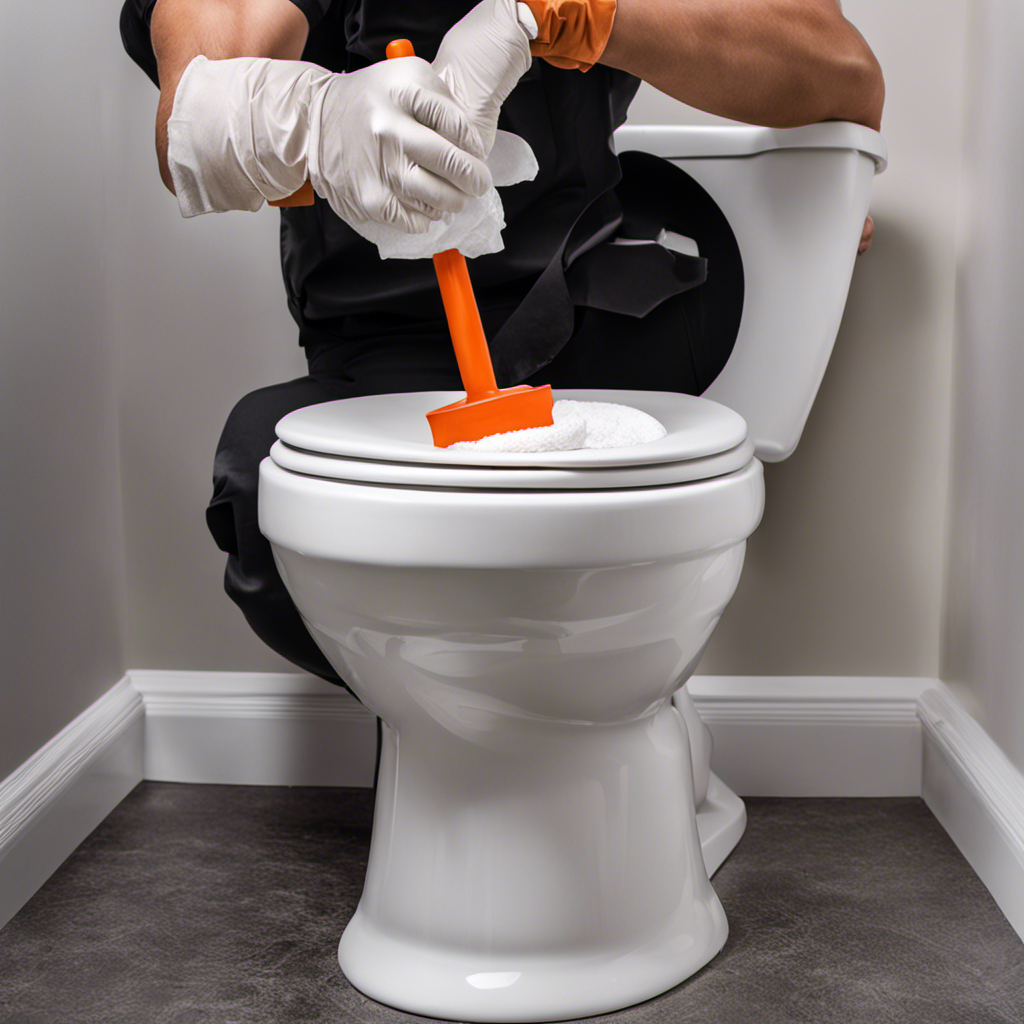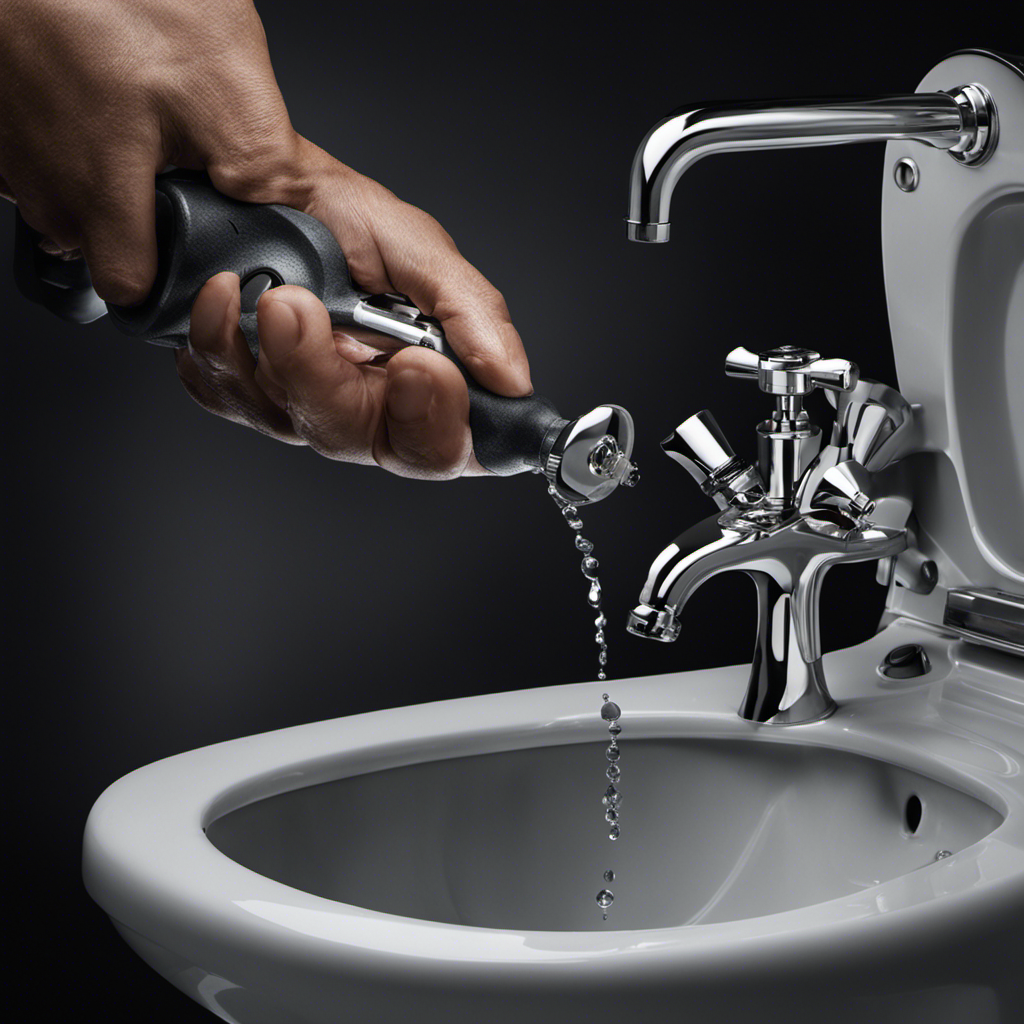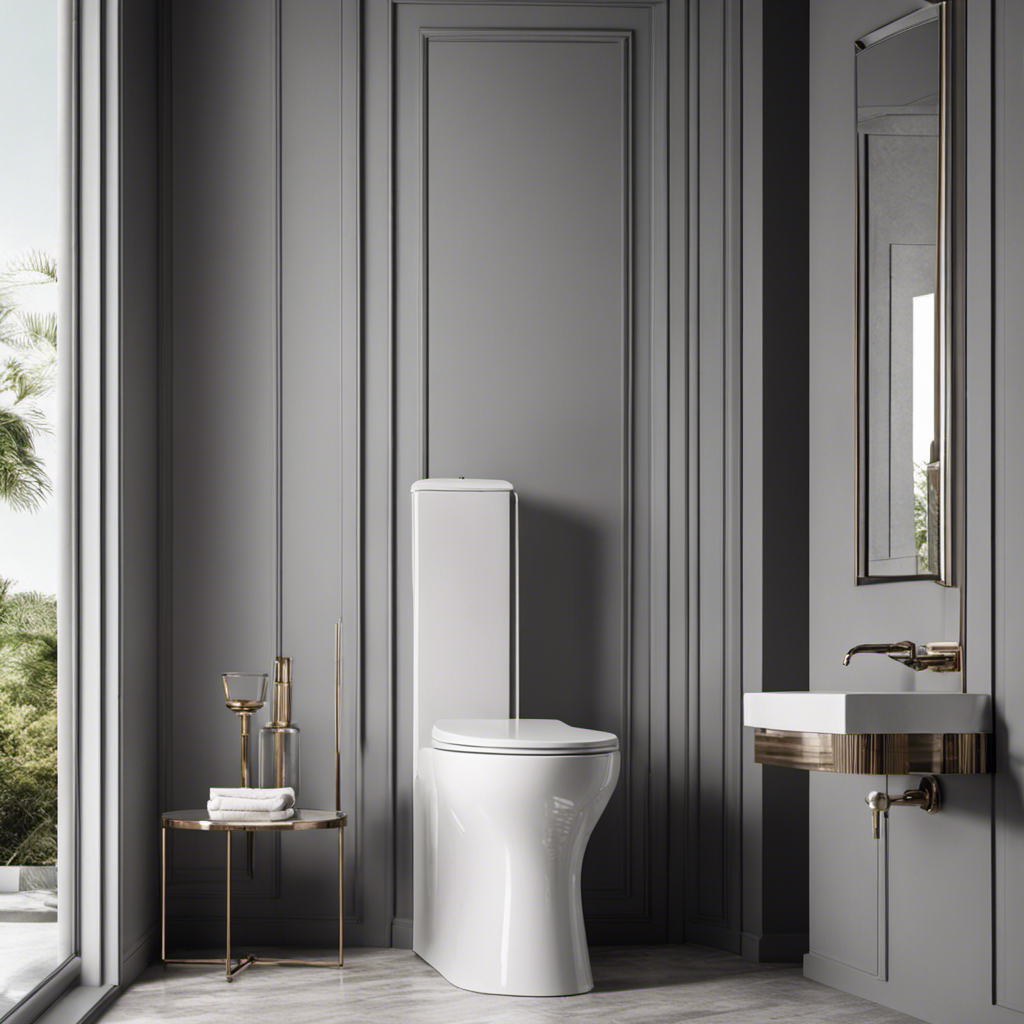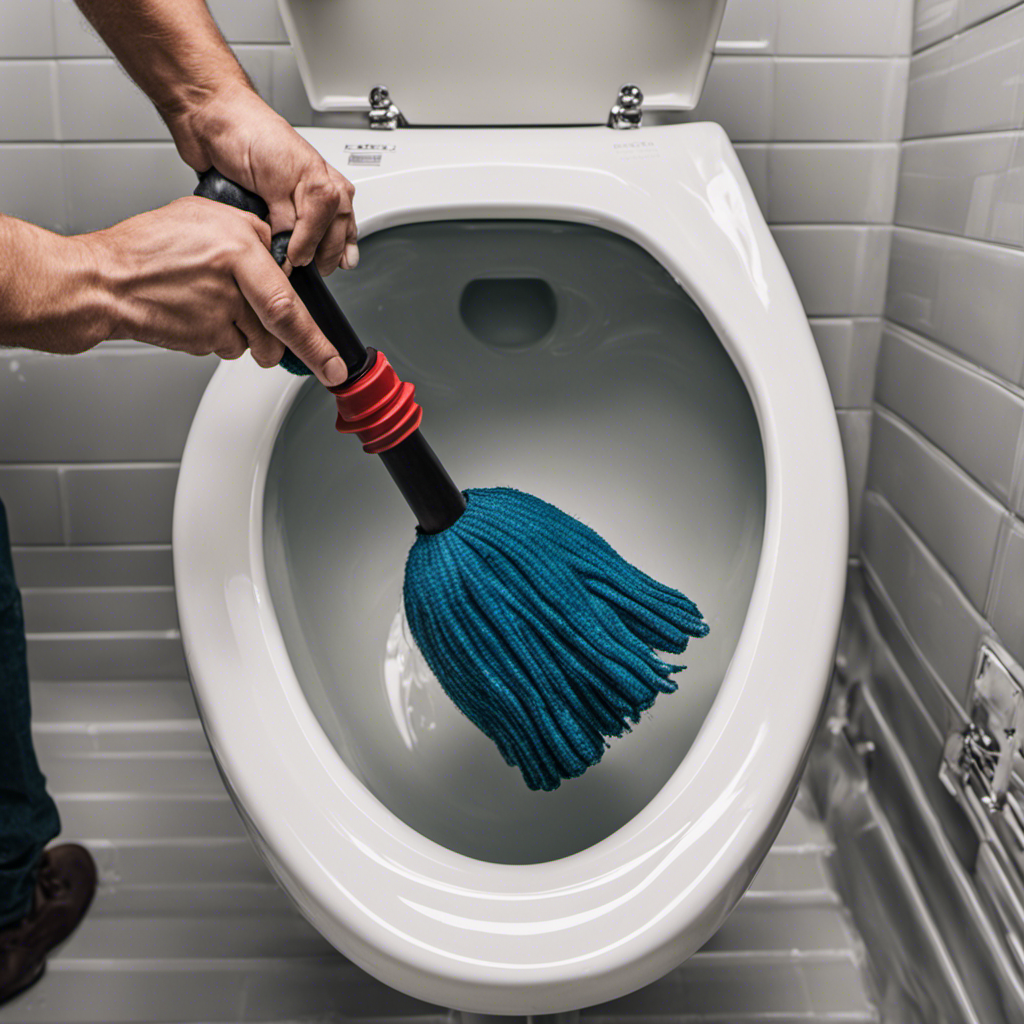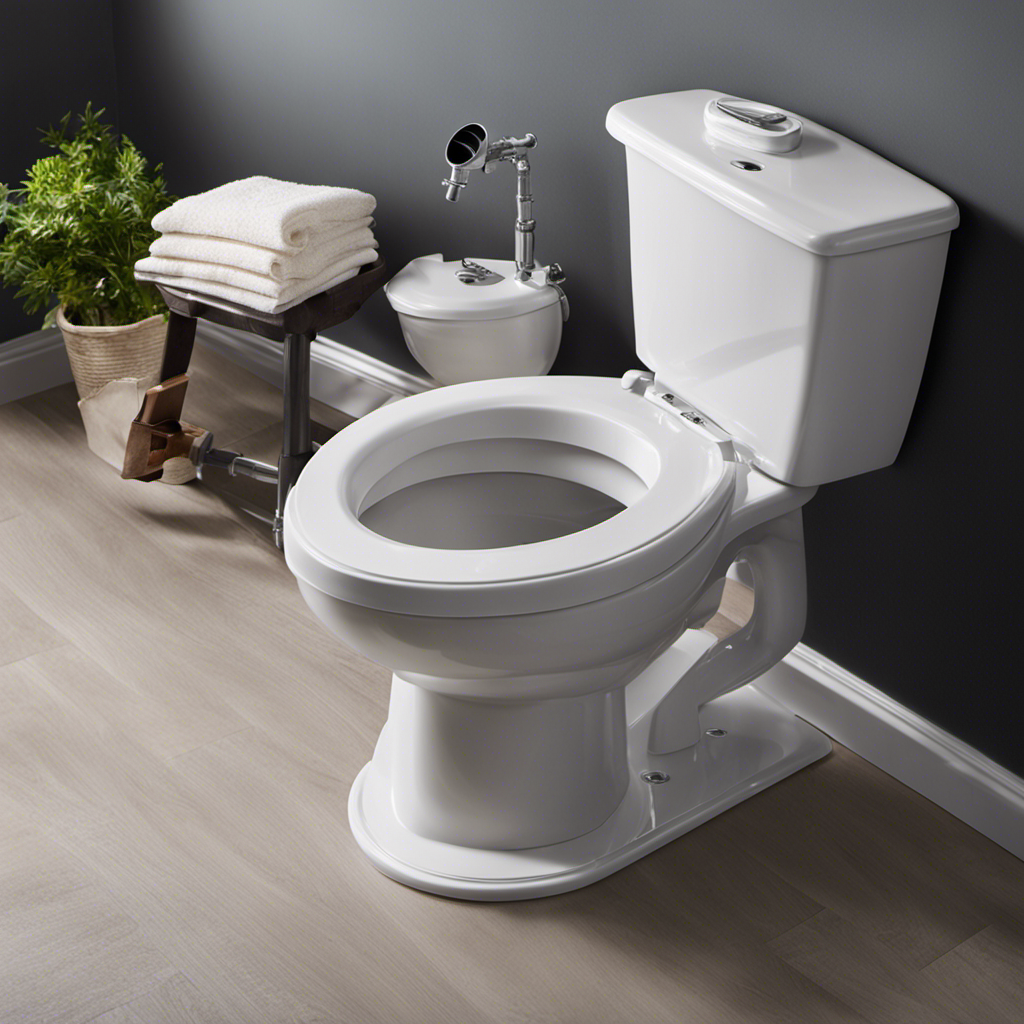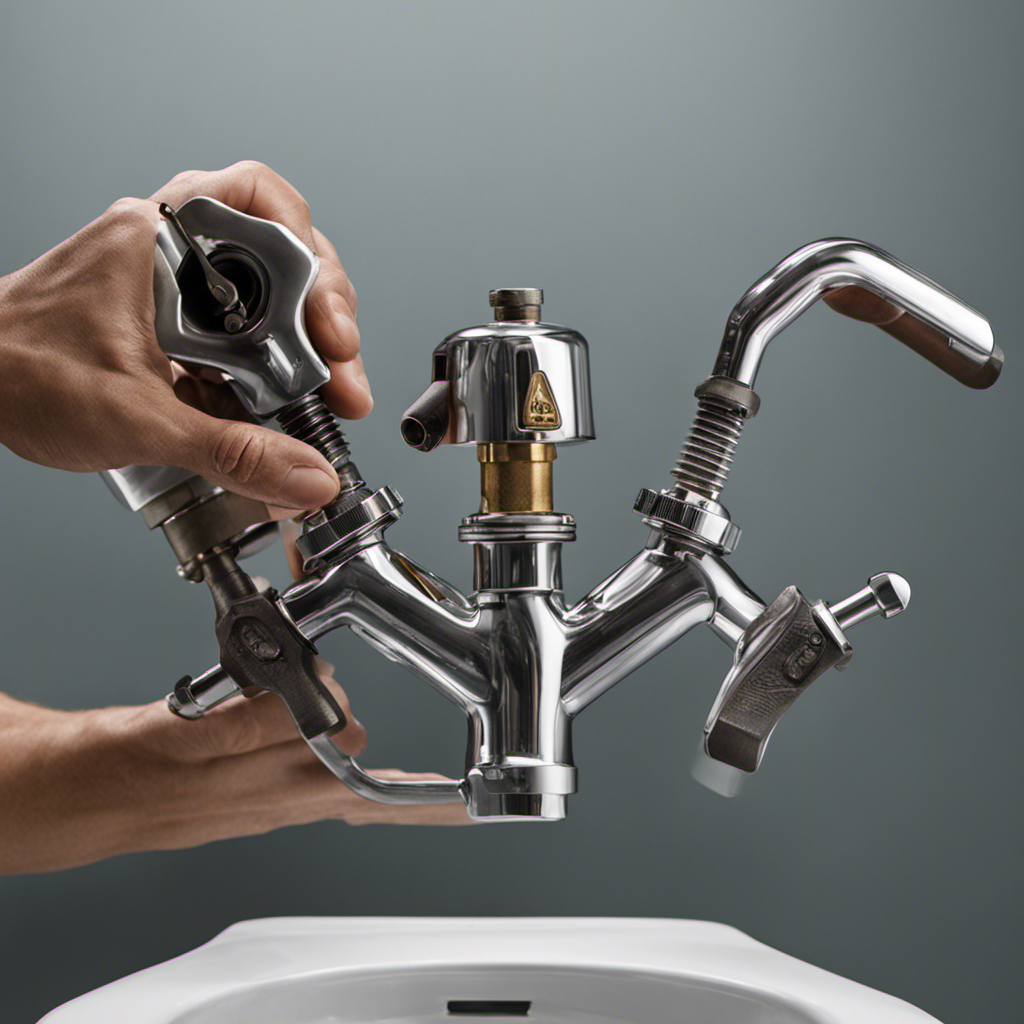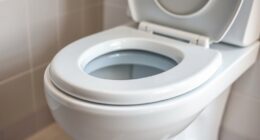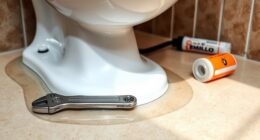I’ve got a problem: a clogged toilet caused by paper towels.
But no worries, because I’ve got the tools, tips, and tricks to fix it.
Rubber gloves, a plunger, and a toilet auger are my weapons of choice.
See, paper towels don’t dissolve like toilet paper, so they tend to cause clogs.
In this article, I’ll guide you through the process of unclogging a toilet with paper towels.
So grab your gloves, let’s get to work!
Key Takeaways
- Rubber gloves, a plunger, and a toilet auger are essential tools for unclogging a toilet.
- Prepare your bathroom by removing rugs, propping up the toilet seat, and eliminating obstacles.
- The plunger method involves creating suction with the plunger to dislodge paper towels stuck in the pipes.
- Using a toilet auger is effective for removing stubborn clogs caused by paper towels, but requires skill and caution.
Essential Tools for Unclogging a Toilet
I need to make sure I have rubber gloves, a plunger, and a toilet auger as the essential tools for unclogging a toilet with paper towels.
When it comes to unclogging techniques, these tools are indispensable. Troubleshooting tips for unclogging a toilet with paper towels include using a plunger and a toilet auger.
With a plunger, I must check if there’s enough water in the toilet bowl and fill it if needed. Then, I securely place the plunger in the bowl and create suction by pulling and pushing the plunger. This helps draw out the paper towels from the pipes.
However, if the plunger is not effective, I can use a toilet auger. The toilet auger has a barbed head and is tall and flexible, allowing it to reach deep into the pipes. By inserting the barbed head into the toilet and spinning the handle, I can dissolve and pull out the paper towels.
It’s important to remove the toilet auger carefully to avoid getting it stuck. Slowly pulling the auger up using the handle and ensuring no waste is clinging to the head will help prevent any mess.
Preparing Your Bathroom for the Task
To prepare for the task, it is important to remove any rugs under the toilet and prop up the toilet seat for easier access. These preparation tips are crucial to ensure a smooth and efficient unclogging process.
By removing rugs, you eliminate any obstacles that may hinder your movements. Propping up the toilet seat provides better visibility and allows you to reach the clog more easily. However, it is essential to be cautious and wear protective gloves to minimize any potential challenges.
Unclogging a toilet can be a messy task, and having the right tools and preparation is key. By following these preparation tips, you can tackle the clog with confidence and minimize any potential challenges that may arise.
The Plunger Method: Step-by-Step Guide
First, check if there’s enough water in the toilet bowl before proceeding with the plunger method. If the water level is too low, add water using a jug.
To use the plunger, securely place it in the bowl and create suction by pulling and pushing it. This will help dislodge any paper towels stuck in the pipes.
However, if you’re looking for toilet plunger alternatives, consider using a toilet auger. Unlike a plunger, a toilet auger has a barbed head and is tall and flexible. Insert the barbed head into the toilet and spin the handle to dissolve and pull out the paper towels.
To prevent toilet clogs in the future, remember to only flush toilet paper and avoid flushing paper towels or other non-flushable items.
Using a Toilet Auger: A Powerful Alternative
Using a toilet auger is an effective way to remove stubborn clogs caused by paper towels. The advantage of using a toilet auger is that it has a barbed head and is tall and flexible, allowing it to reach deep into the pipes for effective unclogging.
Unlike a plunger, a toilet auger can dissolve and pull out paper towels that may already be stuck in the pipes. However, there are limitations to using a toilet auger. It requires more skill and caution to use compared to a plunger, as it involves inserting the barbed head into the toilet and controlling it with the handle.
Additionally, removing the toilet auger requires careful maneuvering to avoid getting it stuck or causing a mess. Overall, a toilet auger is a powerful alternative to unclog toilets, but it requires more precision and care.
Proper Techniques for Operating a Toilet Auger
I find it helpful to insert the barbed head of the toilet auger into the toilet and control it with the handle. This technique allows me to effectively dissolve and remove paper towels that are causing a clog.
However, it is important to ensure proper maintenance of the toilet auger to prevent any problems. Regularly clean the auger after each use to remove any waste that may be clinging to the head. Additionally, check for any signs of wear or damage on the auger’s components.
Troubleshooting common toilet auger problems can involve checking for any blockages or obstructions in the auger’s mechanism. If the auger is not effectively unclogging the toilet, it may be necessary to rotate the handle in different directions or adjust the position of the barbed head.
Safely Removing the Toilet Auger
Carefully removing the toilet auger is important to prevent any damage or mess. When removing the toilet auger, it is crucial to avoid common mistakes and troubleshoot any issues that may arise. Here are three essential tips for safely removing the toilet auger:
-
Slowly pull the auger up using the handle: It is important to take your time and be steady when removing the auger. Avoid quick movements that may cause rotation and create a mess.
-
Ensure no waste is clinging to the auger head: Before pulling the auger out completely, make sure to check that no waste or debris is clinging to the auger head. This will help prevent any mess or potential clogs.
-
Clean and store the auger properly: After removing the auger, clean it thoroughly to remove any residue. Store it in a safe and dry place to ensure its longevity and effectiveness for future use.
Understanding Why Paper Towels Cause Clogs
When it comes to understanding why paper towels cause clogs in toilets, it’s important to consider their design and composition. Unlike toilet paper, which is specifically designed to disintegrate when flushed, paper towels are designed to absorb a large amount of water and have looser inner linings with more empty spaces. This makes them harder to dissolve and more likely to cause clogs when flushed down the toilet.
To avoid the hassle and potential damage caused by clogged toilets, it’s advisable to explore paper towel alternatives and educate ourselves about the environmental impact of paper towels. Using reusable cloth towels or opting for biodegradable alternatives can help reduce the amount of waste generated and prevent potential plumbing issues. By making conscious choices, we can protect our plumbing systems and contribute to a greener and more sustainable future.
| Paper Towel Alternatives | Environmental Impact of Paper Towels |
|---|---|
| Reusable cloth towels | Excessive deforestation |
| Biodegradable options | High water consumption |
| Bamboo or hemp towels | Landfill accumulation |
| Air dryers | Carbon emissions |
| Hand dryers | Pollution from manufacturing |
How Paper Towels Differ From Toilet Paper
Using a plunger or a toilet auger can be effective in unclogging toilets, but it’s important to understand how paper towels differ from toilet paper in order to choose the right tool for the job. Here are the key differences between paper towels and toilet paper:
-
Absorbency: Paper towels are designed to absorb a large amount of water, making them thicker and more resistant to dissolving. On the other hand, toilet paper is specifically made to disintegrate easily when flushed.
-
Design: Paper towels have looser inner linings with more empty spaces, which makes them harder to dissolve. Toilet paper, on the other hand, is made with a more compact design to facilitate quick disintegration.
-
Clogging risk: Due to their absorbency and design, flushing paper towels can cause toilet clogs more easily than flushing toilet paper. It’s important to avoid flushing paper towels to prevent potential plumbing issues.
Understanding these differences will help you choose the right tool and avoid clogs when dealing with paper towels in a clogged toilet.
Preventing Toilet Clogs: Tips and Tricks
Now that we understand the differences between paper towels and toilet paper, let’s focus on preventing toilet clogs and exploring alternative unclogging methods.
Toilet clog prevention is essential for maintaining a properly functioning toilet. One tip is to avoid flushing any items other than toilet paper down the toilet. This includes paper towels, which can easily clog the pipes due to their design and lack of disintegration.
Another preventive measure is to install a drain strainer in the toilet bowl to catch any debris or foreign objects before they enter the pipes. Additionally, regular maintenance, such as using enzymatic cleaners to break down waste buildup, can help prevent clogs.
If a clog does occur, alternative unclogging methods, such as using a toilet snake or chemical drain cleaner, can be considered. However, it is important to exercise caution and follow the instructions carefully when using these methods to avoid damaging the toilet or causing further issues.
Frequently Asked Questions
How Can I Prevent Paper Towels From Clogging My Toilet in the First Place?
To prevent toilet clogs, I avoid flushing paper towels and opt for eco-friendly alternatives. Using toilet paper designed to disintegrate when flushed is a safer choice, as paper towels are harder to dissolve and can cause blockages.
Can I Use a Regular Plunger to Unclog a Toilet or Do I Need a Specific Toilet Plunger?
Yes, a regular plunger can be used to unclog a toilet, but a toilet plunger is specifically designed for better suction and easier unclogging. It is recommended to use a toilet plunger for more effective results.
Is It Safe to Use Chemical Drain Cleaners to Unclog a Toilet?
Using chemical drain cleaners to unclog a toilet can be effective, but there are potential risks. Pros include convenience and quick results, but cons include damage to pipes and harmful fumes.
What Should I Do if the Toilet Is Still Clogged After Using a Plunger and Toilet Auger?
If the toilet is still clogged after using a plunger and toilet auger, I would try unclogging it using household items like a vinegar and baking soda mixture or a wire hanger.
Are There Any Alternative Methods for Unclogging a Toilet Without Using a Plunger or Toilet Auger?
There are alternative methods for unclogging a toilet without a plunger or toilet auger. One method is using hot water and dish soap. It can be effective in breaking down the clog and restoring proper flow.
Conclusion
In conclusion, fixing a clogged toilet caused by paper towels requires the right tools and techniques. By using rubber gloves, a plunger, and a toilet auger, you can effectively unclog the toilet and prevent further damage.
It is interesting to note that according to a study conducted by plumbing experts, paper towels are responsible for nearly 20% of all toilet clogs. Therefore, it is important to dispose of paper towels properly and avoid flushing them down the toilet to maintain a functional plumbing system.
Remember to take your time, be steady, and follow the outlined steps for a successful unclogging process.
